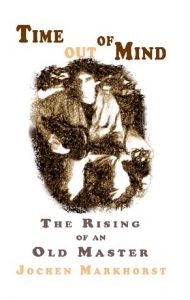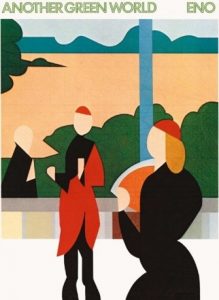This week saw the release of Jochen’s book on Time Out Of Mind; a song-by-song analysis of all the songs on this late masterpiece plus the outtakes “Red River Shore”, “Dreamin’ Of You” and “Marchin’ To The City”. Plus, as a bonus, “Things Have Changed”, which for reasons not entirely clear is considered a TOOM song by Dylan and his publisher.
Available as paperback and e-book in German, English and Dutch on Amazon. The English version is also available as a hardcover: www.amazon.com/dp/B0B47QDLPK
—————————-
Previously
by Jochen Markhorst
II Burning Down The House
 “Whoever does the words has a very hard job. That’s the sharp edge of the music. Whatever else the music is doing, if there are words there, you know that is going to be the focal point of the music for so many listeners. And you can really fuck it up with words. If they’re not good, you can totally wreck the whole thing,” Brian Eno says in an interview with Michael Engelbrecht for the German magazine Jazzthetik (March 1996).
“Whoever does the words has a very hard job. That’s the sharp edge of the music. Whatever else the music is doing, if there are words there, you know that is going to be the focal point of the music for so many listeners. And you can really fuck it up with words. If they’re not good, you can totally wreck the whole thing,” Brian Eno says in an interview with Michael Engelbrecht for the German magazine Jazzthetik (March 1996).
It seems atypical of the grand master of soundscapes, of the artist who, early in his career, increasingly moved away from songs with vocals and made mainly instrumental records. Ten years earlier, in the fascinating account of Eno’s conversation with John Cage in Musician (September 1985), he is quite unambiguous:
“But I have the same feeling about lyrics. I just don’t want to hear them most of the time. They always impose something that is so unmysterious compared to the sound of the music they debase the music for me, in most cases.”
… but it is very much in line with his statements ten years later; Eno loves language, or rather vocals, but not the “de-mystifying” effect that its content can have. “I cut the language up,” he explains, “a few words will come out – space – another word – another six words – space – another two words. So the language really keeps falling apart. In a way, it’s like using language and trying as hard as possible to break the meaning down, and see what’s left. See where the meaning still comes out of it.”
Which does sound very much like William Burroughs’ cut-up technique, and it is, in fact:
“What I did is, I took little tiny phrases, pieces of sentences from a magazine describing Serbian torture in Bosnia, a porno magazine, and an article about homeless people in London. I took these phrases, then I have a randomiser, so that I can start to throw them together in new ways.”
In fact, a copy of Burroughs’ working method, so to speak. And of the writing process that Dylan already imitated in the sixties, and according to writing partner Larry Charles still practices in the twenty-first century, so around Time Out Of Mind as well. Charles, who co-wrote the script for the Dylan film Masked And Anonymous in 2003, reveals that the Bard literally has a box full of slips of paper and torn-off scrap sheets, full of one-line ideas, loose metaphors and whatnot. During the writing process, the box is placed on the table, Dylan turns it over and starts moving snippets back and forth;
 “He takes these scraps and he puts them together and makes his poetry out of that. He has all of these ideas and then just in a subconscious or unconscious way, he lets them synthesize into a coherent thing.
“He takes these scraps and he puts them together and makes his poetry out of that. He has all of these ideas and then just in a subconscious or unconscious way, he lets them synthesize into a coherent thing.
“And that’s how we wound up writing also. We wound up writing in a very ‘cut-up’ technique.”
Explicitly, Eno words his philosophy in the opening track of the wonderful 1975 album Another Green World, in “Sky Saw”;
All the clouds turn to words All the words float in sequence No one knows what they mean Everyone just ignores them
…over which Eno then sings contextless strings of words like “Open stick and delphic doldrums / Open click and quantum data”. But with hindsight, the technique has been recognisable since his first solo album Here Come The Warm Jets (1973). And apparently, Eno also converts David Byrne. The second Talking Heads album produced by the prodigious Briton, Fear Of Music (1978), opens with the song Eno and Byrne wrote together to an adapted text by Dadaist Hugo Ball, “I Zimbra”. The lyrics consist of meaningless strings of words like “A bim beri glassala glandride / E glassala tuffm I zimbra”. The lyrics of the songs on their collaborative project, the 1981 successful My Life In The Bush Of Ghosts, are entirely construed of sampled sound fragments from radio sermons, talk shows and Lebanese singers.
David Byrne can manage without Eno after that, and has learned a valuable lesson: the next world hit “Burning Down The House” is constructed by Byrne, very Dylanesque, from collected scraps, fragments and scribbles. “I [would] just write words to fit that phrasing… I’d have loads and loads of phrases collected that I thought thematically had something to do with one another, and I’d pick from those,” as he reveals in an interview on NPR’s All Things Considered (December 1984). In which he also gives a glimpse of what else can be found in his box: word combinations that were originally included in “Burning Down The House” but were rejected again. “I have another body”, for example, and “Pick it up by the handle”.
It does demonstrate, all in all, a funny art fraternity of Brian Eno, David Byrne and Bob Dylan. Thanks to the release of the outtake “Marchin’ To The City” on The Bootleg Series Vol. 8: Tell Tale Signs (2008), we know that Dylan also used scissors and glue to create “Til I Fell In Love With You”. Apart from the chorus line, the second verse features two lines from that rejected outtake too;
Well, my house is on fire, burning to the sky I thought it would rain but the clouds passed by Now I feel like I’m coming to the end of my way But I know God is my shield and he won’t lead me astray Still I don’t know what I’m gonna do I was all right ’til I fell in love with you
… the first two lines, that is – lines of verse that no doubt emerged from that legendary “very ornate, beautiful box” as well. Which also suggests an unimportant, but again amusingly similar thematic fascination. Eno’s box seems to contain a disproportionate number of word combinations with “fire” and the likes (which is demonstrated in the titles alone; “Baby’s On Fire”, “The Paw Paw Negro Blowtorch”, “Here Come The Warm Jets”, “Burning Airlines Give You So Much More”, “Over Fire Island”, “St. Elmo’s Fire”, “Lava”…). The same applies to the first time David Byrne starts cutting and pasting:
Ah, all wet Hey, you might need a raincoat Shakedown Dreams walking in broad daylight 365 degrees Burning down the house
https://youtu.be/FBUe_v6Mi70
“He takes these scraps and he puts them together and makes his poetry out of that”… Larry Charles’ testimony about Dylan’s methods seems to apply one-to-one to Byrne’s “Burning Down The House”. The coincidental similarities in content with “’Til I Fell In Love With You” are meaningless, of course. On the other hand: “Take something that is all accidents and chance events,” Eno teaches in that same 1996 interview, “and then make it all happen again.”
To be continued. Next up ’Til I Fell In Love With You part 3: Ballad Of A Smalltown Boy
————————-
Jochen is a regular reviewer of Dylan’s work on Untold. His books, in English, Dutch and German, are available via Amazon both in paperback and on Kindle:
- Blood on the Tracks: Dylan’s Masterpiece in Blue
- Blonde On Blonde: Bob Dylan’s mercurial masterpiece
- Where Are You Tonight? Bob Dylan’s hushed-up classic from 1978
- Desolation Row: Bob Dylan’s poetic letter from 1965
- Basement Tapes: Bob Dylan’s Summer of 1967
- Mississippi: Bob Dylan’s midlife masterpiece
- Bob Dylan’s Greatest Hits
- John Wesley Harding: Bob Dylan meets Kafka in Nashville
- Tombstone Blues b/w Jet Pilot: Dylan’s lookin’ for the fuse
- Street-Legal: Bob Dylan’s unpolished gem from 1978
- Bringing It All Back Home: Bob Dylan’s 2nd Big Bang
- Time Out Of Mind: The Rising of an Old Master

If I might add one little extra about lyrics in relation to taking scraps and putting them together, two of us on this site have been involved in such a project, feeding Dylan’s lyrics into an artificial intelligence program and then creating new, slightly Dylanesque songs through the combination of computerisation and human endevour.
The project is summarised with links to earlier articles in the third and final piece on the topic at “The third and final Artificial Intelligence song of Bob Dylan, with added music”
https://bob-dylan.org.uk/archives/23154 on this site.
Thank goodness Dylan does a much better job putting words (from scraps or not) and music together than AI does.
Those who’d have machines replacing real human beings to “create” songs and music for humans to listen to have not achieved their goal as yet.
To be clear Larry, the lyrics were created by AI as an experiment, and not intended as finished songs, nor were they created as equivalent of Bob’s work. I set out the idea of seeing how far such lyrics could be taken, and so added the music (that was not done by machine) and offered the result as part of the on-going project, not in any way as a suggestion that AI + me can be the equivalent of the real thing.
Yes I understood as an experiment but I was thinking about what could happen in the future.
Per usual you did a fine job with the music, but the manufactured AI lyrics (surely not intended to be humorous) were so elongated that I found you had to cram them in by rattling them off at an extremely fast rate….
I found it amazing that you could do that ….
But still too fast for my taste, anyway.
I’m talking about the the song with the “you have to move fast” lyrics
On a second listening maybe it does work….
As a satire, perhaps
These matters are always so subjective!
Correction:
” you better move fast”